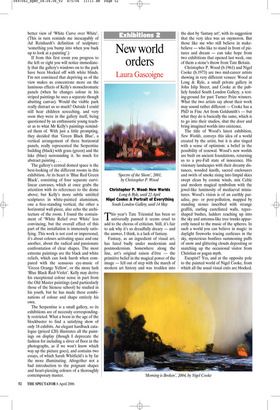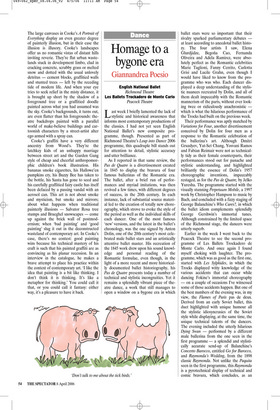New world orders
Laura Gascoigne
Christopher P. Wood: New Worlds Long & Ryle, until 22 April Nigel Cooke: A Portrait of Everything South London Gallery, until 14 May This year’s Tate Triennial has been so universally panned it seems cruel to add to the chorus of criticism. Still, it’s fair to ask why it’s so dreadfully dreary — and the answer, I think, is a lack of fantasy.
Fantasy, as an ingredient of visual art, has fared badly under modernism and postmodernism. Somewhere along the line, art’s original raison d’être — the primitive belief in the magical power of the image — fell out of step with the march of modern art history and was trodden into the dust by ‘fantasy art’, with its suggestion that the very idea was an oxymoron. But those like me who still believe in makebelieve — who like to stand in front of pictures and dream — can take hope from two exhibitions that opened last week, one of them a stone’s throw from Tate Britain.
Christopher P. Wood (b.1961) and Nigel Cooke (b.1973) are two mid-career artists showing in very different venues: Wood at Long & Ryle, a small private gallery in John Islip Street, and Cooke at the publicly funded South London Gallery, a testing-ground for past Turner Prize winners. What the two artists say about their work may sound rather different — Cooke has a PhD in Fine Art from Goldsmith’s — but what they do is basically the same, which is to go into their studios, shut the door and bring imagined worlds into existence.
The title of Wood’s latest exhibition, New Worlds, conveys this idea of a world created by the artist, but it is also tinged with a sense of optimism: a belief in the possibility of renewal. Wood’s new worlds are built on ancient foundations, returning us to a pre-Fall state of innocence. His visionary landscapes with their dreamy distances, wooded knolls, sacred enclosures and swirls of smoke rising into limpid skies swept clean by cosmic winds, mix Celtic and modern magical symbolism with the jewel-like luminosity of mediaeval miniatures. Wood’s vision is of an earthly paradise, preor post-pollution, mapped by standing stones inscribed with strange graffiti, curling castellated walls, tepeeshaped bushes, ladders reaching up into the sky and antenna-like tree trunks apparently tuned to the music of the spheres. In such a world you can believe in magic: in daylight fireworks tracing curlicues in the sky, mysterious bonfires summoning puffs of snow and glittering clouds depositing or snatching up the occasional visitor from Christian or pagan myth.
Escapist? Yes, and at the opposite pole to the painted world of Nigel Cooke, from which all the usual visual exits are blocked. The large canvases in Cooke’s A Portrait of Everything display an even greater degree of painterly illusion, but in their case the illusion is illusory. Cooke’s landscapes offer us no romantic vistas of distant hills inviting reverie. They’re flat urban wastelands stuck in development limbo, clad in cracking concrete, scrubby grass or melted snow and dotted with the usual unlovely detritus — cement blocks, graffitied walls and stunted trees — left by the receding tide of modern life. And when your eye tries to seek relief in the misty distance, it is brought up short by the shadow of a foreground tree or a graffitied doodle painted across what you had assumed was the sky. Cooke’s backgrounds, it turns out, are even flatter than his foregrounds: theatre backdrops painted with a parallel world of make-believe buildings and cartoonish characters by a street-artist alter ego armed with a spray can.
Cooke’s graffiti have a very different ancestry from Wood’s. They’re the latchkey kids of an unhappy marriage between street art and the Garden Gang style of cheap and cheerful anthropomorphic children’s book illustration. His bananas smoke cigarettes, his Hallowe’en pumpkins cry, his Buzzy Bee has taken to the bottle, his Santa has gone to seed and his carefully graffitied fairy castle has itself been defaced by a passing vandal with an aerosol can. This art is not about smoke and mysticism, but smoke and mirrors; about what happens when traditional painterly illusions — Salvator Rosa tree stumps and Brueghel snowscapes — come up against the brick wall of postmodernism; when ‘bad painting’ and ‘good painting’ slug it out in the deconstructed wasteland of contemporary art. In Cooke’s case, there’s no contest: good painting wins because his technical mastery of his craft is such that his painted graffiti are as convincing as his planar recession. In an interview in the catalogue, he makes a brave attempt to place his practice within the context of contemporary art. ‘I like the idea that painting is a bit like thinking. I don’t think it is thinking. It’s like a metaphor for thinking.’ You could call it that, or you could call it fantasy: either way, it’s a pleasure to have it back.











































































 Previous page
Previous page